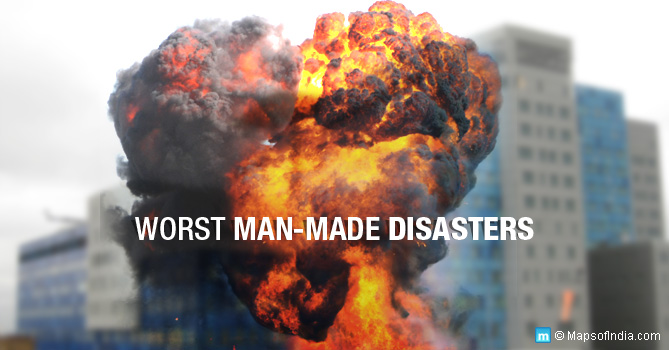India has seen its fair share of disasters over the years resulting in significant loss of lives. While nature’s behaviour is not in human hands, reducing its impact certainly is.
But the bigger concern has been man-made disasters that have been a result of human carelessness, callousness, or sheer lack of foresight and planning that has ended up with large number of innocent people losing lives, all of which were preventable.
It is appalling to see that the government seems to learn nothing from each tragedy and life just seems to move on with little concern or value for human life. But it’s not government alone that must be blamed, after all, it’s we the people, that allow the government of the day to move on with little accountability or punishment to those in power at the political, bureaucratic or business level. It’s time for accountability.
Here are 5 worst man-made disasters in India.
Bhopal Gas tragedy
Recalling the night of December 2-3 1984 in Bhopal still sends a shiver down the spine of those who were there that fateful night when toxic Methyl Isocyanate (MIC) gas leaked from the factory owned by Union Carbide. The gas silently spread out engulfing the densely populated areas around the factory.
People woke up and ran outside desperately gasping for breath only to take in more of the deadly gas. Many died in their sleep while others went blind. Over time, several people suffered from post trauma diseases, while many continue to suffer even today.
This was one of the worst chemical disasters globally that resulted in over 10,000 losing their lives (the actual number remains disputed) and over 5.5 lakh persons affected and suffering from agonizing injuries.
The tragedy was a result of human error and poor supervision at the factory. Unfortunately, several industries in India still continue to operate with very little government pressure on implementation of safety protocols as per Standard Operating Procedures laid down by the authorities.
AMRI Hospital fire, Kolkata
It was early December morning in Kolkata when a fire broke out at the basement of AMRI Hospital in Dhakuria area of Kolkata. It was around 3 am on the morning of 9 December 2011 when most patients and attending staff were asleep.
The fire spread rapidly to the floors above. Patients were trapped inside wards and with no exit possible as all windows were grilled, the rapidly spreading smoke did more damage than the fire itself.
The staff were slow to react and got bogged down in protocol rather than call in the fire department immediately as the fire broke.
The first responders at the site were the slum dwellers residing next to the hospital who took up the initiative of rescuing the patients. They managed to access the hospital through windows, by breaking the grills, and rescued several patients and staff.
At the end, of the 160 persons inside the hospital at the time, 89 lost their lives, of which 85 were patients and 4 staff members.
This was a classic case of negligence on part of management and operational staff, who did not implement most of the mandatory fire safety norms, as laid down by the government. Adding to this was lack of clear Standard Operating Procedures for such emergencies.
Few lessons have been learnt since as several hospitals and public buildings in Kolkata and other cities, continue to remain a potential tinder box.
Girish Park Kolkata Flyover Collapse
The most recent man-made disaster occurred on 31 March at 12.25 pm when a portion of the under construction Vivekananda Road flyover at Girish Park crossing collapsed, crushing 18 people to death and leaving over 78 injured. At the time of writing, several still remain buried under the debris.
Construction work on the 2.2 kilometer flyover began in 2009 but has been way behind schedule with several deadlines missed. It is reported that the project cost has escalated significantly over the years and the builder had been pressing the West Bengal government to release funds, which has not been forthcoming, as per amount or schedule required.
The delays in completing the project were mainly on account of several land acquisition litigations that the government had to settle but for the past several months the principle contractor IVRCL, a Hyderabad based builder, was under pressure from the state government to complete the project, with an eye on forthcoming elections.
While only a detailed technical investigation will reveal the reasons behind the tragedy, there is no doubt on the culpability of all stakeholders that set aside caution and technical logic in trying to complete the project.
It is still early to conclude whether poor design and/or poor construction material contributed to the tragedy but it is clear that lack of supervision on part of the authorities led the contractor to be lax on quality monitoring as construction progressed.
While this flyover collapse was not the first in Kolkata or India, can we say with confidence that this would be the last?
Lalita Park Building Collapse
On 15 November 2010, a five storey residential building in a crowded neighbourhood of Lalita Park in West Delhi came crashing down like a pack of cards. 66 people lost their lives with over 80 injured. The cause of collapse was attributed to poor quality of construction, illegal addition of floors and recent floods in the city, all contributing to the building crashing under its own weight.
The incident once again highlighted official apathy towards illegal construction and poor monitoring of existing buildings that pose a threat. Similar incidents keep occurring in many cities at regular intervals, with little or no preventive measures adopted subsequently.
Maha Kumbh mela stampede in Allahabad and thereafter
Stampede caused by poor people management and lack of adequate infrastructure to monitor and manage large crowd gatherings, especially during religious occasions, has been a bane in India, with few lessons learnt.
One of the worst incidents took place just after independence on 3 February 1954 on the occasion of Maha Kumbh in Allahabad. The resulting stampede took the lives of 820 and left over 100 injured.
Similar incident occurred at Mandher Devi temple in Wai, district Satara in Maharashtra on 26 January 2005, when a stampede led to 350 persons being killed and left over 200 injured.
Several other stampedes have taken place over the years with deadly results.
What more will it take for the authorities in all states to wake up and take responsibility to ensure such incidents don’t happen?
Explore more :
Top 10 Natural Calamities in India
List of Major Rail Accidents in india





